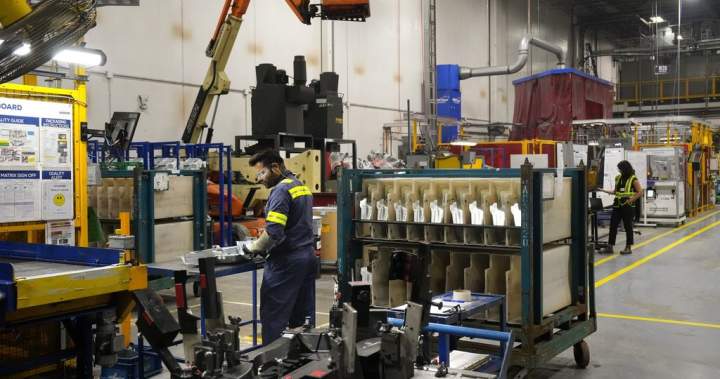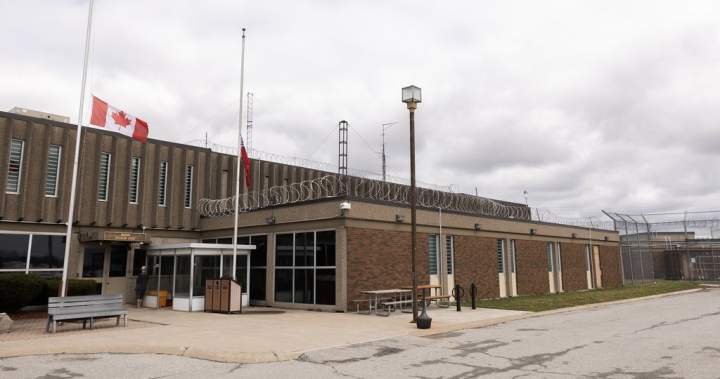Ontario should rejig supports for small auto businesses in wake of tariffs, CFIB says

Ontario should rejig its programs meant to support auto businesses through the impact of tariffs and associated economic uncertainty, as the way they’re currently structured is leaving small businesses in the lurch, an advocacy group says in a new report.
The Canadian Federation of Independent Business released a report Wednesday based on a survey of 187 small-to-medium-sized businesses in the automotive sector, from parts suppliers to repair shops, and found that tariffs are already having an impact.
Their revenue has declined by 13 per cent, on average, and half of them reported that they have paused or cancelled investments due to uncertainty caused by the Canada-U.S. trade war, which could lead to billions in lost revenue or missed investments, the report said.
“It’s impossible for a business owner to really know what’s going on these days,” Joseph Falzata, co-author of the report and policy analyst with CFIB Ontario, said of the whiplash trade policy news.
“I do this as my full-time job, and it’s always difficult for myself. So you can only imagine a business owner who’s working 50, 60 hours a week trying to keep track of things.”

Get breaking National news
For news impacting Canada and around the world, sign up for breaking news alerts delivered directly to you when they happen.
Their revenue is taking a hit in part because they are paying higher prices and there is confusion about which products are affected by tariffs, as well as due to costs associated with seeking out new supply chains, Falzata said.
Ontario has programs meant to help shore up businesses in the automotive sector, but while appreciated, they’re missing the mark when it comes to supporting smaller businesses, the CFIB report says.
In its spring budget the provincial government said it was putting $85 million into two programs: the Ontario Automobile Modernization Program to help parts suppliers upgrade equipment and the Ontario Vehicle Innovation Network for research and development.
“Though these programs have been created with good intentions, few small businesses plan to use them, and over a third of them are ineligible,” the CFIB report says.
“The programs focus on R&D innovation and large-scale manufacturing, while disregarding the reality that most automotive (small and medium businesses) either cannot afford or are not involved in these processes.”
A new $50-million Ontario Together Trade Fund meant to help businesses develop new markets and find domestic supply chains, requires businesses to show a revenue loss of at least 30 per cent and requires them to put up $200,000 of their own capital, which the report calls “a luxury most (small and medium businesses) cannot afford.”
The government said its programs have already helped hundreds of businesses, with the Ontario Vehicle Innovation Network supporting more than 600 small and medium businesses since its inception in 2019 and the Ontario Automotive Modernization Program has supported 215 projects since 2021.
“In the face of unprecedented global economic uncertainty, our government is protecting and building on the progress we have made to champion small businesses in the auto sector and across the economy,” Jennifer Cunliffe, a spokesperson for Economic Development Minister Vic Fedeli, wrote in a statement.
The best way to help small businesses would be to lower the small business tax rate from 3.2 per cent to two per cent, the CFIB said. The government lowered the rate from 3.5 per cent in 2020.
© 2025 The Canadian Press


The Canadian Institute for Health Information says e-scooter injuries are on the rise across the country.
It released data Thursday saying that hospitalizations involving e-scooters for kids between five and 17 years old increased by 61 per cent from 2022-23 to 2023-24.
The agency said hospitalizations for men between 18 and 64 went up by 22 per cent in that time period and went up by 60 per cent for women.
The data shows the majority of e-scooter hospitalizations happened in Ontario, Quebec, Alberta and British Columbia.
Dr. Daniel Rosenfield, a pediatric emergency physician at SickKids Hospital in Toronto, said the number of kids and teens arriving in the emergency department with e-scooter injuries has been increasing over the last five years and some have been “catastrophic,” including one 13-year-old boy’s death in 2023.
“We see anything from minor scrapes and cuts and little lacerations that need a couple of stitches to … traumatic brain injury, internal bleeding in the chest and abdomen, open fractures that need to go to the operating room to be fixed,” he said.
Some children between four and six years old have been hurt while riding with their parents on an e-scooter, Rosenfield said, but injuries among teens riding on their own is more common.

Among cases where the information is available, 80 per cent of the riders who end up in the ER aren’t wearing helmets, he said.

Get daily National news
Get the day’s top news, political, economic, and current affairs headlines, delivered to your inbox once a day.
Rosenfield said he thinks the rise in injuries correlates to an increase in the popularity and affordability of e-scooters in recent years — together with a lack of understanding about how dangerous they can be.
“These scooters, much like everything electrified these days, have come down in price and have increased in power,” he said.
“Their acceleration and torque is tremendous. And most parents, when they’re buying these things for their kids, are completely unaware of that.”
Pamela Fuselli, president and CEO of Parachute Canada — a charity focused on injury prevention — said the laws around e-scooters vary between provinces and even municipalities.
In Ontario, riders must be at least 16 years old. But in Toronto, e-scooters are not allowed on public roads or paths. And just east of the city in Oshawa, they’re permitted under a pilot program.
But people are clearly using them even where they’re not allowed, Fuselli said.
“Even while a city may have a bylaw about this, they can regulate what’s operated in public spaces, but then that has to be enforced. They can’t really regulate what’s sold,” she said.

Fuselli said kids under 16 should not be riding e-scooters — and parents shouldn’t be buying them for children younger than that.
“They look like toys, but they really are motor vehicles,” she said.
This report by The Canadian Press was first published July 17, 2025.
Canadian Press health coverage receives support through a partnership with the Canadian Medical Association. CP is solely responsible for this content.
© 2025 The Canadian Press

Most new measles cases in Ontario over the past week were reported in a popular summer travel area.
Public Health Ontario is reporting 32 new measles cases, 19 of which are in Huron Perth.
The public health unit located west of Kitchener includes Stratford, known for its annual theatre festival, as well as Lake Huron beach spots including Clinton and Goderich.

Get weekly health news
Receive the latest medical news and health information delivered to you every Sunday.
That brings Ontario’s total case count to 2,276 since an outbreak began last fall.
Public health experts have encouraged cautious optimism on Ontario’s slowing case counts given the ebb and flow of the highly contagious infectious disease.
Alberta is also battling an outbreak, reaching 1,340 total cases since the outbreak there began in March. It surpassed the United States’ case count earlier this week.
Also this week, New Brunswick declared a measles outbreak and has reported five confirmed cases in the south-central region of the province.
© 2025 The Canadian Press

Ontario’s solicitor general says the province is adding 150 beds to three jails across the province using modular construction.
Michael Kerzner made the announcement Thursday at the Niagara Detention Centre, which will expand by 50 spaces, as will the Vanier Centre for Women in Milton, and the Cecil Facer Youth Centre in Sudbury, which is also being converted to an adult facility.

Get daily National news
Get the day’s top news, political, economic, and current affairs headlines, delivered to your inbox once a day.
Construction is expected to begin next year and cost the province more than $180 million.
The announcement comes not long after the province’s ombudsman raised concerns about an overcrowding “crisis” in Ontario’s correctional facilities, saying some are operating at more than 150 per cent of their capacity, compromising safety for inmates and staff alike.
Premier Doug Ford has also recently been pushing the federal government for stricter bail laws and urging judges and justices of the peace not to let violent, repeat offenders out on bail when they are charged with a new crime.
Provincial jails hold people accused of a crime but not out on bail, as well as those serving sentences of two years less a day, but the vast majority fit into the first category and have not been convicted.
© 2025 The Canadian Press
-

 Uncategorized1 month ago
Uncategorized1 month agoShop Proud, Eat Proud, Be Proud — Ottawa Canada Day Market This June 28th
-

 1 month ago
1 month agoCanada’s world junior trial saw juries tossed, intense testimony. Here’s a recap
-

 1 month ago
1 month agoMeasles circulating in northeastern B.C. community, health officials warn
-

 1 month ago
1 month agoAnishinabek Nation chief says he briefed Ontario police on protests against Bill 5
-

 1 month ago
1 month agoRing of Fire road to bring prosperity to First Nation, problems for caribou: report
-

 1 month ago
1 month agoJagmeet Singh apologizes for attending Kendrick Lamar concert after Drake calls him out
-

 1 month ago
1 month agoFormer major leaguer, Jays doctor Ron Taylor dies
-

 1 month ago
1 month agoDreaming of a lakeside cottage but can’t afford it? Co-ownership could open that door






